List of organisms by chromosome count
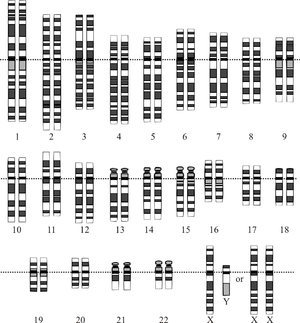
Karyotype of a human being, showing 22 pair of autosomal chromosomes and both the XX female and the XY male possibilities for the pair of sex chromosome

Fusion of ancestral chromosomes left distinctive remnants of telomeres, and a vestigial centromere. As other non-human extant hominidae have 48 chromosomes it is believed that the human chromosome 2 is the end result of the merging of two chromosomes.[1]
The list of organisms by chromosome count describes ploidy or numbers of chromosomes in the cells of various plants, animals, protists, and other living organisms. This number, along with the visual appearance of the chromosome, is known as the karyotype,[2][3][4] and can be found by looking at the chromosomes through a microscope. Attention is paid to their length, the position of the centromeres, banding pattern, any differences between the sex chromosomes, and any other physical characteristics.[5] The preparation and study of karyotypes is part of cytogenetics.
Diploid number ("2n") is given, except as noted.
| Organism | Picture | Group | Scientific name | Diploid number of chromosomes (2n = x), except as noted | Notes |
|---|---|---|---|---|---|
| Ciliated protozoa | 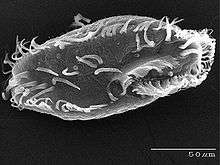 | Other Eukaryotes | Oxytricha trifallax | 1,900x = ~30,000,000 [6][7] | Macronuclear "nanochromosomes"; ampliploid. |
| Ciliated protozoa |  | Other Eukaryotes | Tetrahymena thermophila | 10 (in micronucleus) | 50x = 12,500 (in macronucleus, except minichromosomes) 10,000x = 10,000 (macronuclear minichromosomes)[8] |
| Black mulberry | | Plants | Morus nigra | 308 [9] | In this case, the chromosome number is docosaploid, or 22 times the basic number. |
| Agrodiaetus butterfly | Animals | Agrodiaetus shahrami | 268 [10] | This insect has one of the highest chromosome numbers among all multicellular animals. | |
| Adders-tongue |  | Plants | Ophioglossum | 240 | n=120–720 with a high degree of polyploidization[11] n=720 in hexaploid species O. reticulatum. A google book search for "ophioglossum reticulatum chromosomes" returns values of 2n=768 and 2n=1260, though these sources may be wp:circular and unreliable. |
| Field horsetail | 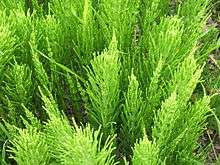 | Plants | Equisetum arvense | 216 | |
| Rattlesnake fern | | Plants | Botrypus virginianus | 184[12] | |
| Northern lamprey | Animals | Petromyzontinae | 174[13] | ||
| Carp | 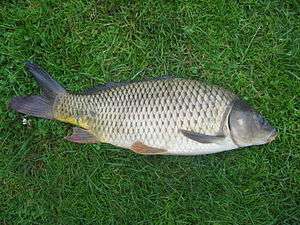 | Animals | 104 | ||
| Red viscacha rat |  | Animals | Tympanoctomys barrerae | 102 [14] | Highest number known in mammals, thought to be a tetraploid[15] or allotetraploid.[16] |
| Kamraj (fern) |  | Plants | Helminthostachys zeylanica | 94 | |
| Aquatic rat | Animals | Anotomys leander | 92[17] | Previously thought to be the highest number in mammals, tied with Ichthyomys pittieri. | |
| Shrimp | 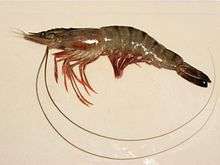 | Animals | Penaeus semisulcatus | 86–92 [18] | |
| Pittier's crab-eating rat | Animals | Ichthyomys pittieri | 92[17] | Previously thought to be the highest number in mammals, tied with Anotomys leander. | |
| Grape fern | 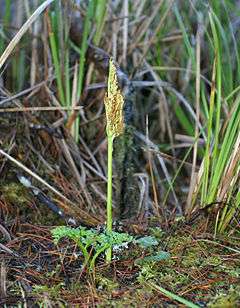 | Plants | Sceptridium | 90 | |
| Hedgehog Genus Atelerix (African hedgehogs) | 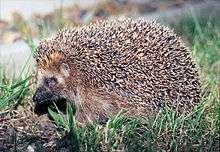 | Animals | 90 | ||
| Moonworts |  | Plants | Botrychium | 90 | |
| Hedgehog genus Erinaceus (woodland hedgehogs) | .jpg) | Animals | 88 | ||
| Great white shark |  | Animals | Carcharodon carcharias | 82[19] | |
| Pigeon | | Animals | Columbidae | 80 [20] | |
| Turkey |  | Animals | Meleagris | 80[21] | |
| Tropical pitcher plant |  | Plants | Nepenthes rafflesiana | 78 [22] | |
| African wild dog | .jpg) | Animals | Lycaon pictus | 78[23] | |
| Chicken |  | Animals | Gallus gallus domesticus | 78 | |
| Coyote | 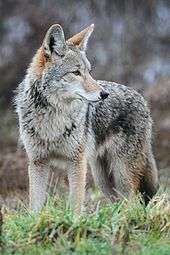 | Animals | Canis latrans | 78[23] | |
| Dhole |  | Animals | Cuon alpinus | 78 | |
| Dingo | | Animals | Canis lupus dingo | 78[23] | |
| Dog |  | Animals | Canis lupus familiaris | 78[24] | 76 autosomal and 2 sexual.[25] |
| Dove | 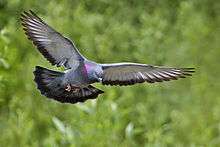 | Animals | Columbidae | 78[26] | Based on African collared dove |
| Golden jackal | 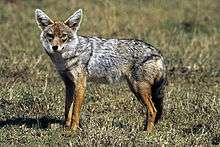 | Animals | Canis aureus | 78[23] | |
| Gray wolf | 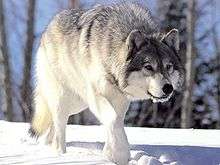 | Animals | Canis lupus | 78 | |
| Maned wolf | 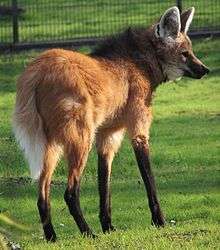 | Animals | Chrysocyon brachyurus | 76 | |
| American black bear |  | Animals | Ursus americanus | 74 | |
| Asiatic black bear |  | Animals | Ursus thibetanus | 74 | |
| Brown bear | _running.jpg) | Animals | Ursus arctos | 74 | |
| Polar bear |  | Animals | Ursus maritimus | 74 | |
| Sloth bear | | Animals | Melursus ursinus | 74 | |
| Sun bear | 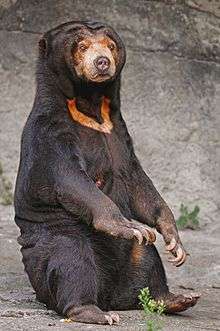 | Animals | Helarctos malayanus | 74 | |
| Bat-eared fox | .jpg) | Animals | Otocyon megalotis | 72[23] | |
| Black nightshade | 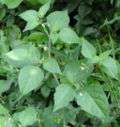 | Plants | Solanum nigrum | 72[27] | |
| White-tailed deer |  | Animals | Odocoileus virginianus | 70 | |
| Elk (Wapiti) |  | Animals | Cervus canadensis | 68 | |
| Red deer |  | Animals | Cervus elaphus | 68 | |
| Gray fox |  | Animals | Urocyon cinereoargenteus | 66[23] | |
| Raccoon dog | .jpg) | Animals | Nyctereutes procyonoides | 66 | Some variation in the number of chromosomes between individuals [28] |
| Chinchilla | 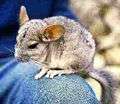 | Animals | Chinchilla lanigera | 64 [29] | |
| Echidna |  | Animals | 63/64 | 63 (X1Y1X2Y2X3Y3X4Y4X5, male) and 64 (X1X1X2X2X3X3X4X4X5X5, female)[30] | |
| Fennec fox |  | Animals | Vulpes zerda | 64[23] | |
| Horse |  | Animals | Equus ferus caballus | 64 | |
| Spotted skunk | 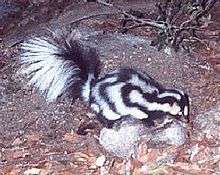 | Animals | Spilogale x | 64 | |
| Mule |  | Animals | 63 | semi-infertile (odd number of chromosomes - between donkey (62) and horse (64) makes meiosis much more difficult) | |
| Donkey | 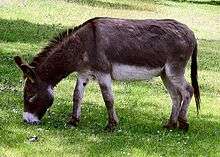 | Animals | Equus africanus asinus | 62 | |
| Giraffe |  | Animals | Giraffa camelopardalis | 62 | |
| Gypsy moth | 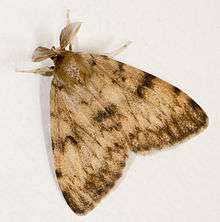 | Animals | Lymantria dispar dispar | 62 | |
| Bengal fox |  | Animals | Vulpes bengalensis | 60 | |
| American bison | 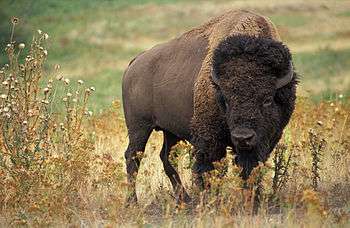 | Animals | Bison bison | 60 | |
| Cow/Bull |  | Animals | Bos primigenius | 60 | |
| Goat | 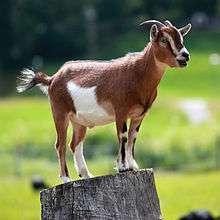 | Animals | Capra aegagrus hircus | 60 | |
| Yak |  | Animals | Bos mutus | 60 | |
| Woolly mammoth |  | Animals | Mammuthus primigenius | 58 | extinct; tissue from a frozen carcass |
| Elephant |  | Animals | Elephantidae | 56 | |
| Gaur |  | Animals | Bos gaurus | 56 | |
| Capuchin monkey | | Animals | Cebus x | 54[31] | |
| Hyrax |  | Animals | Hyracoidea | 54[32] | Hyraxes are considered to be the closest living relative to the Elephant.[33] |
| Sheep |  | Animals | Ovis orientalis aries | 54 | |
| Silkworm | | Animals | Bombyx mori | 54 | |
| Cotton | | Plants | Gossypium hirsutum | 52[34] | 2n=4x; Cultivated upland cotton is derived from an allotetraploid |
| Platypus |  | Animals | Ornithorhynchus anatinus | 52 [35] | Ten sex chromosomes. |
| Spectacled bear | | Animals | Tremarctos ornatus | 52 | |
| Kit fox |  | Animals | Vulpes macrotis | 50 | |
| Pineapple |  | Plants | Ananas comosus | 50[34] | |
| Striped skunk | _DSC_0030.jpg) | Animals | Mephitis mephitis | 50 | |
| Water buffalo (swamp type) | 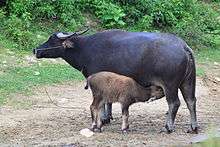 | Animals | Bubalus bubalis | 50 | |
| Zebrafish | 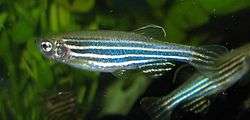 | Animals | Danio rerio | 50[36] | |
| Beaver (Eurasian) | 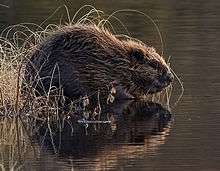 | Animals | Castor fiber | 48 | |
| Chimpanzee |  | Animals | Pan troglodytes | 48[37] | |
| Deer mouse |  | Animals | Peromyscus maniculatus | 48 | |
| Gorilla |  | Animals | Gorilla | 48 | |
| Hare[38][39] | 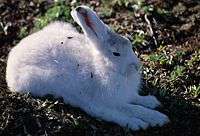 | Animals | Lepus | 48 | |
| Orangutan |  | Animals | Pongo x | 48 | |
| Potato |  | Plants | Solanum tuberosum | 48[34] | This is a tetraploid; wild relatives mostly have 2n=24.[34] |
| Tobacco | 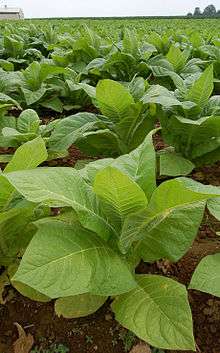 | Plants | Nicotiana tabacum | 48[34] | Cultivated species is a tetraploid.[34] |
| Water buffalo (river type) | Animals | Bubalus bubalis | 48 | ||
| Human | | Animals | Homo sapiens | 46[40] | 44 autosomal and 2 sex |
| Reeves's muntjac |  | Animals | Muntiacus reevesi | 46 | |
| Sable antelope | _adult_male.jpg) | Animals | Hippotragus niger | 46 | |
| Dolphin |  | Animals | Delphinidae Delphi | 44 | |
| Moon jellyfish | | Animals | Aurelia aurita | 44 [41] | |
| Eurasian badger | 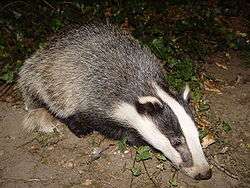 | Animals | Meles meles | 44 | |
| European rabbit | 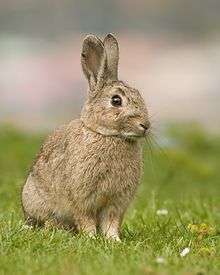 | Animals | Oryctolagus cuniculus | 44 | |
| Fossa |  | Animals | Cryptoprocta ferox | 42 | |
| Giant panda |  | Animals | Ailuropoda melanoleuca | 42 | |
| Oats | | Plants | Avena sativa | 42[34] | This is a hexaploid with 2n=6x=42. Diploid and tetraploid cultivated species also exist.[34] |
| Raccoon dog | 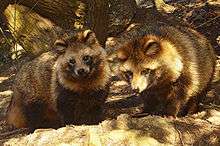 | Animals | Nyctereutes procyonoides | 42 | some sources say sub-species differ with 38, 54, and even 56 chromosomes |
| Rat | 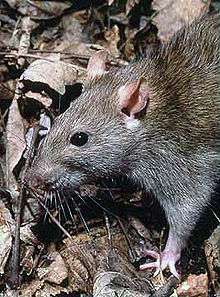 | Animals | Rattus norvegicus | 42 [42] | |
| Rhesus monkey | 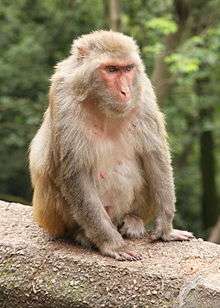 | Animals | Macaca mulatta | 42[43] | |
| Wheat | _3.jpg) | Plants | Triticum aestivum | 42[34] | This is a hexaploid with 2n=6x=42. Durum wheat is Triticum turgidum var. durum, and is a tetraploid with 2n=4x=28.[34] |
| Wolverine | 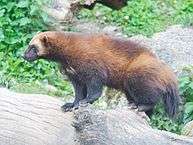 | Animals | Gulo gulo | 42 | |
| Beaver (American) |  | Animals | Castor canadensis | 40 | |
| European polecat |  | Animals | Mustela putorius | 40 | |
| Ferret |  | Animals | Mustela putorius furo | 40 | |
| Hyena | 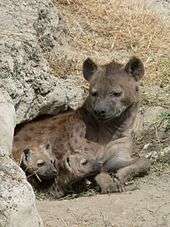 | Animals | Hyaenidae | 40 | |
| Mango |  | Plants | Mangifera indica | 40[34] | |
| Mouse | 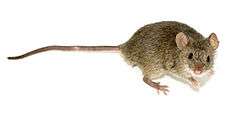 | Animals | Mus musculus | 40[44] | |
| Trans-Pecos ratsnake |  | Animals | Bogertophis subocularis | 40[45] | |
| African clawed frog |  | Animals | Xenopus laevis | 38[46] | |
| American marten |  | Animals | Martes americana | 38 | |
| Baja California ratsnake |  | Animals | Bogertophis rosaliae | 38[47] | |
| Beech marten |  | Animals | Martes foina | 38 | |
| Cat |  | Animals | Felis silvestris catus | 38 | |
| Coatimundi |  | Animals | 38 | ||
| European mink |  | Animals | Mustela lutreola | 38 | |
| Fisher |  | Animals | 38 | a type of marten | |
| Lion | 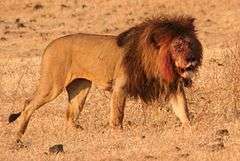 | Animals | Panthera leo | 38 | |
| Oriental small-clawed otter | 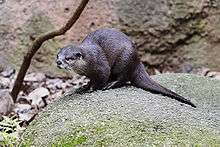 | Animals | Aonyx cinerea | 38 | |
| Pig | .jpg) | Animals | Sus | 38 | |
| Pine marten | 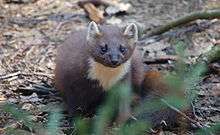 | Animals | Martes martes | 38 | |
| Raccoon | .jpg) | Animals | Procyon lotor | 38[48] | |
| Sable |  | Animals | Martes zibellina | 38 | |
| Sea otter |  | Animals | Enhydra lutris | 38 | |
| Tanuki/raccoon dog | Animals | Nyctereutes procyonoides albus | 38 | ||
| Tiger | 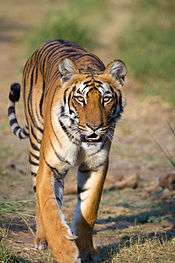 | Animals | Panthera tigris | 38 | |
| Earthworm |  | Animals | Lumbricus terrestris | 36 | |
| Long-nosed cusimanse |  | Animals | crossarchus obscurus | 36 | |
| Meerkat |  | Animals | Suricata suricatta | 36 | |
| Red panda | 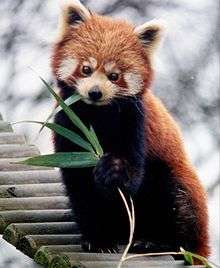 | Animals | Ailurus fulgens | 36 | |
| Starfish |  | Animals | Asteroidea | 36 | |
| Tibetan sand fox | 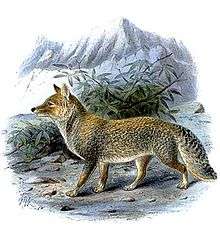 | Animals | Vulpes ferrilata | 36 | |
| Yellow mongoose |  | Animals | Cynictis penicillata | 36 | |
| Porcupine |  | Animals | Erethizon dorsatum | 34 [29] | |
| Red fox |  | Animals | Vulpes vulpes | 34[23] | Plus 3-5 microsomes. |
| Alfalfa |  | Plants | Medicago sativa | 32[34] | page=165/> |
| American badger | | Animals | Taxidea taxus | 32 | |
| European honey bee |  | Animals | Apis mellifera | 32 | 32 for females, males are haploid and thus have 16. |
| Yeast | 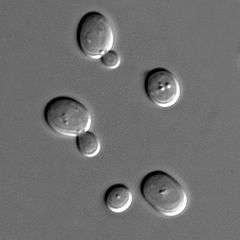 | Other Eukaryotes | Saccharomyces cerivisiae | 32 | |
| American mink | 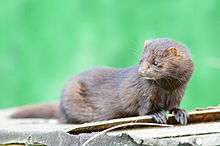 | Animals | Neovison vison | 30 | |
| Pill millipede |  | Animals | Arthrosphaera magna attems | 30 | [49] |
| Bittersweet nightshade |  | Plants | Solanum dulcamara | 24[50][51] | |
| Husk tomato |  | Plants | Physalis pubescens | 24[52] | |
| Silverleaf nightshade |  | Plants | Solanum elaeagnifolium | 24[53] | |
| Rice |  | Plants | Oryza sativa | 24[34] | |
| Snail |  | Animals | 24 | ||
| Bean | | Plants | Phaseolus sp. | 22[34] | All species in the genus have the same chromosome number, including P. vulgaris, P. coccineus, P. acutifolis,and P. lunatus.[34] |
| Virginia opossum |  | Animals | Didelphis virginiana | 22[54] | |
| Australian pitcher plant | 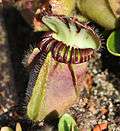 | Plants | Cephalotus follicularis | 20 [22] | |
| western clawed frog |  | Animals | Xenopus tropicalis | 20[46] | |
| Cannabis | | Plants | Cannabis sativa | 20 | |
| Maize |  | Plants | Zea mays | 20[34] | |
| Cabbage | 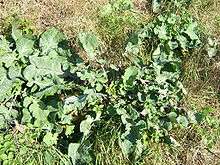 | Plants | Brassica oleracea | 18[34] | Broccoli, cabbage, kale, kohlrabi, brussels sprouts, and cauliflower are all the same species and have the same chromosome number.[34] |
| Radish | .jpg) | Plants | Raphanus sativus | 18[34] | |
| Kangaroo |  | Animals | 16 | This includes several members genus Macropus, but not the red kangaroo (M. rufus, 20)[55] | |
| Koala | 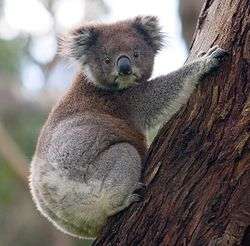 | Animals | Phascolarctos cinereus | 16 | |
| Barley |  | Plants | Hordeum vulgare | 14[34] | |
| Pea |  | Plants | Pisum sativum | 14[34] | |
| Rye |  | Plants | Secale cereale | 14[34] | |
| Tasmanian devil |  | Animals | Sarcophilus harrisii | 14 | |
| Slime mold | | Other Eukaryotes | Dictyostelium discoideum | 12 [56] | |
| Swamp wallaby |  | Animals | Wallabia bicolor | 10/11 | 11 for male, 10 for female[57] |
| Nematode | | Animals | Caenorhabditis elegans | 12/11 | 12 for hermaphrodites, 11 for males |
| Waterwheel plant |  | Plants | Aldrovanda vesiculosa | 38 [22] | |
| Thale cress | 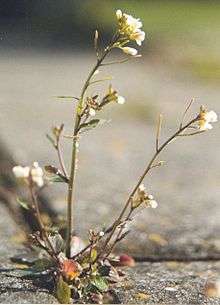 | Plants | Arabidopsis thaliana | 10 | |
| Fruit fly | .jpg) | Animals | Drosophila melanogaster | 8[58] | 6 autosomal, and 2 sexual |
| Hieracium |  | Plants | 8 | ||
| Indian muntjac | | Animals | Muntiacus muntjak | 6/7[59] | female/male |
| Yellowfever mosquito | 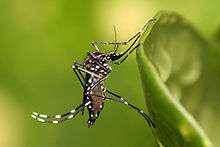 | Animals | Aedes aegypti | 6[60] | The 2n=6 chromosome number is conserved in the entire family Culicidae, except in Chagasia bathana which has 2n=8.[60] |
| Spider mite | 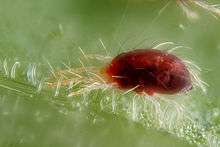 | Animals | 4–14[61] | Spider mites (family Tetranychidae) are typically haplodiploidy (males are haploid, while females are diploid)[61] | |
| Australian daisy |  | Plants | Brachyscome dichromosomatica | 4 [62] | This species can have more B chromosomes than A chromosomes at times, but 2n=4. |
| Jack jumper ant |  | Animals | Myrmecia pilosula | 2[63] | 2 for females, males are haploid and thus have 1; smallest number possible. Other ant species have more chromosomes.[63] |
Notes
See also
References
- ↑ Avarello; et al. (1992). "Evidence for an ancestral alphoid domain on the long arm of human chromosome 2". Human Genetics. 89 (2): 247–9. doi:10.1007/BF00217134. PMID 1587535.
- ↑ Concise Oxford Dictionary
- ↑ White 1973, p. 28
- ↑ Stebbins, G.L. (1950). "Chapter XII: The Karyotype". Variation and evolution in plants. Columbia University Press.
- ↑ King, R.C.; Stansfield, W.D.; Mulligan, P.K. (2006). A dictionary of genetics (7th ed.). Oxford University Press. p. 242.
- ↑ Estienne C. Swart; John R. Bracht; Vincent Magrini; Patrick Minx; Xiao Chen; Yi Zhou; Jaspreet S. Khurana; Aaron D. Goldman; Mariusz Nowacki; Klaas Schotanus; Seolkyoung Jung; Robert S. Fulton; Amy Ly; Sean McGrath; Kevin Haub; Jessica L. Wiggins; Donna Storton; John C. Matese; Lance Parsons; Wei-Jen Chang; Michael S. Bowen; Nicholas A. Stover; Thomas A. Jones; Sean R. Eddy; Glenn A. Herrick; Thomas G. Doak; Richard K. Wilson; Elaine R. Mardis; Laura F. Landweber (2013-01-29). "The Oxytricha trifallax Macronuclear Genome: A Complex Eukaryotic Genome with 16,000 Tiny Chromosomes". PLOS. 11: e1001473. doi:10.1371/journal.pbio.1001473. PMC 3558436
 . PMID 23382650. Retrieved 2014-04-29.
. PMID 23382650. Retrieved 2014-04-29. - ↑ "You Have 46 Chromosomes. This Pond Creature Has 15,600", National Geographic, .
- ↑ Mochizuki, K (2010). "DNA rearrangements directed by non-coding RNAs in ciliates". Wiley Interdiscip Rev RNA. 1: 376–87. doi:10.1002/wrna.34. PMC 3746294
 . PMID 21956937.
. PMID 21956937. - ↑ Kichisaburō Minamizawa (1997). Moriculture. CRC Press. p. 170. ISBN 9789054102878. Retrieved 29 August 2014.
- ↑ Lukhtanov; et al. (2005). "Reinforcement of pre-zygotic isolation and karyotype evolution in Agrodiaetus butterflies". Nature. 436 (3704): 385–389. doi:10.1038/nature03704.
- ↑ Lukhtanov, Vladimir (2015-07-10). "The blue butterfly Polyommatus (Plebicula) atlanticus (Lepidoptera, Lycaenidae) holds the record of the highest number of chromosomes in the non-polyploid eukaryotic organisms". Comparative Cytogenetics. 9 (4): 683–690. doi:10.3897/compcytogen.v9i4.5760.
- ↑ Flora of North America Editorial Committee, eds (1993). "Flora of North America". Chromosoma. Missouri Botanical Garden, St. Louis. 103: 708–14. PMID 7664618.
- ↑ William N. Eschmeyer. "Family Petromyzontidae - Northern lampreys".
- ↑ Contreras LC, Torres-Mura JC, Spotorno AE (1990). "The largest known chromosome number for a mammal, in a South American desert rodent". Experientia. 46 (5): 506–508. doi:10.1007/BF01954248. PMID 2347403.
- ↑ Gallardo MH, Bickham JW, Honeycutt RL, Ojeda RA, Köhler N (1999). "Discovery of tetraploidy in a mammal". Nature. 401 (6751): 341. Bibcode:1999Natur.401..341G. doi:10.1038/43815.
- ↑ Gallardo, M.H.; González, CA; Cebrián, I (2006), "Molecular cytogenetics and allotetraploidy in the red vizcacha rat, Tympanoctomys barrerae (Rodentia, Octodontidae)", Genomics (published August 2006), 88 (2), pp. 214–221, doi:10.1016/j.ygeno.2006.02.010, PMID 16580173, retrieved 21 August 2014
- 1 2 Schmid, M.; Fernández-Badillo, A.; Feichtinger, W.; Steinlein, C.; Roman, J.I. (1988). "On the highest chromosome number in mammals". Cytogenetics and Cell Genetics. 49 (4): 305–8. doi:10.1159/000132683. PMID 3073914.
- ↑ Hosseini SJ, Elahi E, Raie RM (2004). "The Chromosome Number of the Persian Gulf Shrimp Penaeus semisulcatus". Iranian Int. J. Sci. 5 (1): 13–23.
- ↑ Gregory, T.R. (2015). Animal Genome Size Database. http://www.genomesize.com/result_species.php?id=1701
- ↑ Susumu Ohno; Christina Stenius; L. C. Christian; Willy Beçak; Maria Luiza Beçak (1964). "Chromosomal uniformity in the avian subclass Carinatae". Chromosoma. 14: 280–288. doi:10.1007/BF00321513.
- ↑ Muhammad L Aslam; John WM Bastiaansen; Richard PMA Crooijmans; Addie Vereijken; Hendrik-Jan Megens; Martien AM Groenen. "A SNP based linkage map of the turkey genome reveals multiple intrachromosomal rearrangements between the Turkey and Chicken genomes" (PDF). BMC Genomics. 11: 647. doi:10.1186/1471-2164-11-647.
- 1 2 3 Kondo, Katsuhiko (May 1969). "Chromosome Numbers of Carnivorous Plants". Bulletin of the Torrey Botanical Club. 96 (3): 322. doi:10.2307/2483737. JSTOR 2483737.
- 1 2 3 4 5 6 7 8 Sillero-Zubiri, Claudio; Hoffmann, Michael J.; Dave Mech (2004). Canids: Foxes, Wolves, Jackals and Dogs: Status Survey and Conservation Action Plan. World Conservation Union. ISBN 2-8317-0786-2.
- ↑ Lindblad-Toh K, Wade CM, Mikkelsen TS, et al. (December 2005). "Genome sequence, comparative analysis and haplotype structure of the domestic dog". Nature. 438 (7069): 803–19. Bibcode:2005Natur.438..803L. doi:10.1038/nature04338. PMID 16341006.
- ↑ http://www.ncbi.nlm.nih.gov/genome/guide/dog/
- ↑ Guttenbach M, Nanda I, Feichtinger W, Masabanda JS, Griffin DK, Schmid M (2003). "Comparative chromosome painting of chicken autosomal paints 1-9 in nine different bird species". Cytogenetic and Genome Research. 103 (1-2): 173–84. doi:10.1159/000076309. PMID 15004483.
- ↑ Smith, Hugh (1927). "Chromosome counts in the varieties of Solanum tuberosum and allied wild species". Genetics. 12: 84–92.
- ↑ Måkinen, Auli (1986). "A chromosome-banding study in the Finnish and the Japanese raccoon dog". Hereditas. 105: 97–105. doi:10.1111/j.1601-5223.1986.tb00647.x.
- 1 2 http://resources.metapress.com/pdf-preview.axd?code=3180kk1kk0873012&size=largest
- ↑ Rens, W.; et al. (2007). "The multiple sex chromosomes of platypus and echidna are not completely identical and several share homology with the avian Z". Genome Biology. 8 (11): R243. doi:10.1186/gb-2007-8-11-r243. PMC 2258203
 . PMID 18021405.
. PMID 18021405. - ↑ Barnabe, Renato Campanarut; Guimarães, Marcelo Alcindo de Barros Vaz; Oliveira, CláUdio Alvarenga de; Barnabe, Alexandre Hyppolito (2002). "Analysis of some normal parameters of the spermiogram of captive capuchin monkeys (Cebus apella Linnaeus, 1758 )". Brazilian Journal of Veterinary Research and Animal Science. 39. doi:10.1590/S1413-95962002000600010.
- ↑ O'Brien, Stephen J., Meninger, Joan C., Nash, William G. (2006). Atlas of Mammalian Chromosomes. John Wiley & sons. p. 78. ISBN 978-0-471-35015-6.
- ↑ "Hyrax: The Little Brother of the Elephant", Wildlife on One, BBC TV.
- 1 2 3 4 5 6 7 8 9 10 11 12 13 14 15 16 17 18 19 20 21 22 Simmonds, NW (ed.) (1976). Evolution of crop plants. New York: Longman. ISBN 0-582-44496-9.
- ↑ Warren; et al. (2008). "Genome analysis of the platypus reveals unique signatures of evolution" (PDF). Nature. 453 (7192): 175–183. Bibcode:2008Natur.453..175W. doi:10.1038/nature06936. PMC 2803040
 . PMID 18464734.
. PMID 18464734. - ↑ http://genome.cshlp.org/content/10/12/1890.long
- ↑ Young WJ, Merz T, Ferguson-Smith MA, Johnston AW (June 1960). "Chromosome number of the chimpanzee, Pan troglodytes". Science. 131 (3414): 1672–3. Bibcode:1960Sci...131.1672Y. doi:10.1126/science.131.3414.1672. PMID 13846659.
- ↑ T.J. Robinson; F. Yang; W.R. Harrison (2002). "Chromosome painting refines the history of genome evolution in hares and rabbits (order Lagomorpha)". Cytogenetic and Genome Research. 96 (1-4): 223–227. doi:10.1159/000063034. PMID 12438803.
- ↑ "4.W4". Rabbits, Hares and Pikas. Status Survey and Conservation Action Plan. pp. 61–94.
- ↑ "Human Genome Project". National Center for Biotechnology Information. Retrieved 2009-04-29.
- ↑ Diupotex-Chong, Maria Esther; Ocaña-Luna, Alberto; Sánchez-Ramírez, Marina (July 2009). "Chromosome analysis of Linné, 1758 (Scyphozoa: Ulmaridae), southern Gulf of Mexico". Marine Biology Research. 5 (4): 399–403. doi:10.1080/17451000802534907. Retrieved 7 October 2015.
- ↑ http://www.ncbi.nlm.nih.gov/assembly/GCF_000001895.5
- ↑ Moore, CM; Dunn, BG; McMahan, CA; Lane, MA; Roth, GS; Ingram, DK; Mattison, JA (2007). "Effects of calorie restriction on chromosomal stability in rhesus monkeys (Macaca mulatta)". Age (Dordr). 29: 15–28. doi:10.1007/s11357-006-9016-6. PMC 2267682
 . PMID 19424827.
. PMID 19424827. - ↑ The Jackson Laboratory: Mice with chromosomal aberrations.
- ↑ : Chromosomes of Elaphe subocularis (Reptilia: Serpentes), with the description of an in vivo technique for preparation of snake chromosomes.
- 1 2 Matsuda, Y; Uno, Y; Kondo, M; Gilchrist, MJ; Zorn, AM; Rokhsar, DS; Schmid, M; Taira, M (April 2015). "A New Nomenclature of Xenopus laevis Chromosomes Based on the Phylogenetic Relationship to Silurana/Xenopus tropicalis.". Cytogenetic and Genome Research. 145 (3-4): 187–191. doi:10.1159/000381292. PMID 25871511.
- ↑ : Mengden, Greg. 1985. In Dowling, H.G. and. RM. Price. 1988. A proposed new genus for Elaphe subocularis and Elaphe rosaliae. The Snake 20(1): 53, 61.
- ↑ Perelman PL, Graphodatsky AS, Dragoo JW, Serdyukova NA, Stone G, Cavagna P, Menotti A, Nie W, O'Brien PC, Wang J, Burkett S, Yuki K, Roelke ME, O'Brien SJ, Yang F, Stanyon R (2008). "Chromosome painting shows that skunks (Mephitidae, Carnivora) have highly rearranged karyotypes". Chromosome Res. 16 (8): 1215–31. doi:10.1007/s10577-008-1270-2. PMID 19051045.
- ↑ Achar, K.P. (1986). "Analysis of male meiosis in seven species of Indian pill-millipede". Caryologia (39): 89–101.
- ↑ Abrams, L. (1951). Illustrated Flora of the Pacific States. Volume 3. Stanford University Press. p. 866.
- ↑ Stance, C. (1997). New Flora of the British Isles. Second Edition. Cambridge, UK. p. 1130.
- ↑ Liang, X; Bing, W. (April 2004). "[Karyotype analysis of Physalis pubescens chromosome](article in Chinese)". Zhong Yao Cai. 27 (4): 238–239.
- ↑ Heiser, Charles B.; Whitaker, Thomas W. (1948). "Chromosome Number, Polyploidy, and Growth Habit in California Weeds". American Journal of Botany. 35 (3): 179–186. doi:10.2307/2438241.
- ↑ Biggers JD, Fritz HI, Hare WC, McFeely RA (June 1965). "Chromosomes of American Marsupials". Science. 148 (3677): 1602–3. Bibcode:1965Sci...148.1602B. doi:10.1126/science.148.3677.1602. PMID 14287602.
- ↑ Rofe, R. H. (December 1978). "G-banded chromosomes and the evolution of macropodidae". Australian Mammalogy. 2: 50–63. ISSN 0310-0049. Retrieved July 15, 2011.
- ↑ "First of six chromosomes sequenced in Dictyostelium discoideum". Genome News Network. Retrieved 2009-04-29.
- ↑ Toder (Jun 1997). "Comparative chromosome painting between two marsupials: origins of an XX/XY1Y2 sex chromosome system.". Mammalian Genome. 8 (6): 418–22. doi:10.1007/s003359900459. PMID 9166586.
- ↑ "Drosophila Genome Project". National Center for Biotechnology Information. Retrieved 2009-04-14.
- ↑ Wurster, Doris H. & Kurt Benirschke (12 June 1970). "Indian Momtjac, Muntiacus muntiak: A Deer with a Low Diploid Chromosome Number". Science. 168 (3937): 1364–1366. Bibcode:1970Sci...168.1364W. doi:10.1126/science.168.3937.1364. PMID 5444269.
- 1 2 Francesco Giannelli; Hall, Jeffrey C.; Dunlap, Jay C.; Friedmann, Theodore (1999). Advances in Genetics, Volume 41 (Advances in Genetics). Boston: Academic Press. p. 2. ISBN 0-12-017641-6.
- 1 2 Helle, W.; Bolland, H. R.; Gutierrez, J. (1972). "Minimal chromosome number in false spider mites (Tenuipalpidae)". Experientia. 28 (6): 707. doi:10.1007/BF01944992.
- ↑ Leach; et al. (1995). "Organisation and origin of a B chromosome centromeric sequence from Brachycome dichromosomatica". Chromosoma. 103 (10): 708–714. doi:10.1007/BF00344232.
- 1 2 Crosland, M.W.J., Crozier, R.H. (1986). "Myrmecia pilosula, an ant with only one pair of chromosomes". Science. 231 (4743): 1278. Bibcode:1986Sci...231.1278C. doi:10.1126/science.231.4743.1278. PMID 17839565.
External links
- List of pages in English from Russian bionet site
- The dog through evolution
- Shared synteny of human chromosome 17 loci in Canids
- An atlas of the chromosome numbers in animals (1951); PDF downloads of each chapter
- Bell, G. (1982). The Masterpiece of Nature: The Evolution and Genetics of Sexuality (University of California Press, Berkeley), p. 450, (table with a compilation of haploid chromosome number of many algae and protozoa, in column "HAP").
- Nuismer, S.; Otto, S.P. (2004). "Host-parasite interactions and the evolution of ploidy". Proc. Natl. Acad. Sci. USA. 101: 11036–11039. doi:10.1073/pnas.0403151101. (Supporting Data Set, with information on ploidy level and number of chromosomes of several protists)
This article is issued from Wikipedia - version of the 12/1/2016. The text is available under the Creative Commons Attribution/Share Alike but additional terms may apply for the media files.